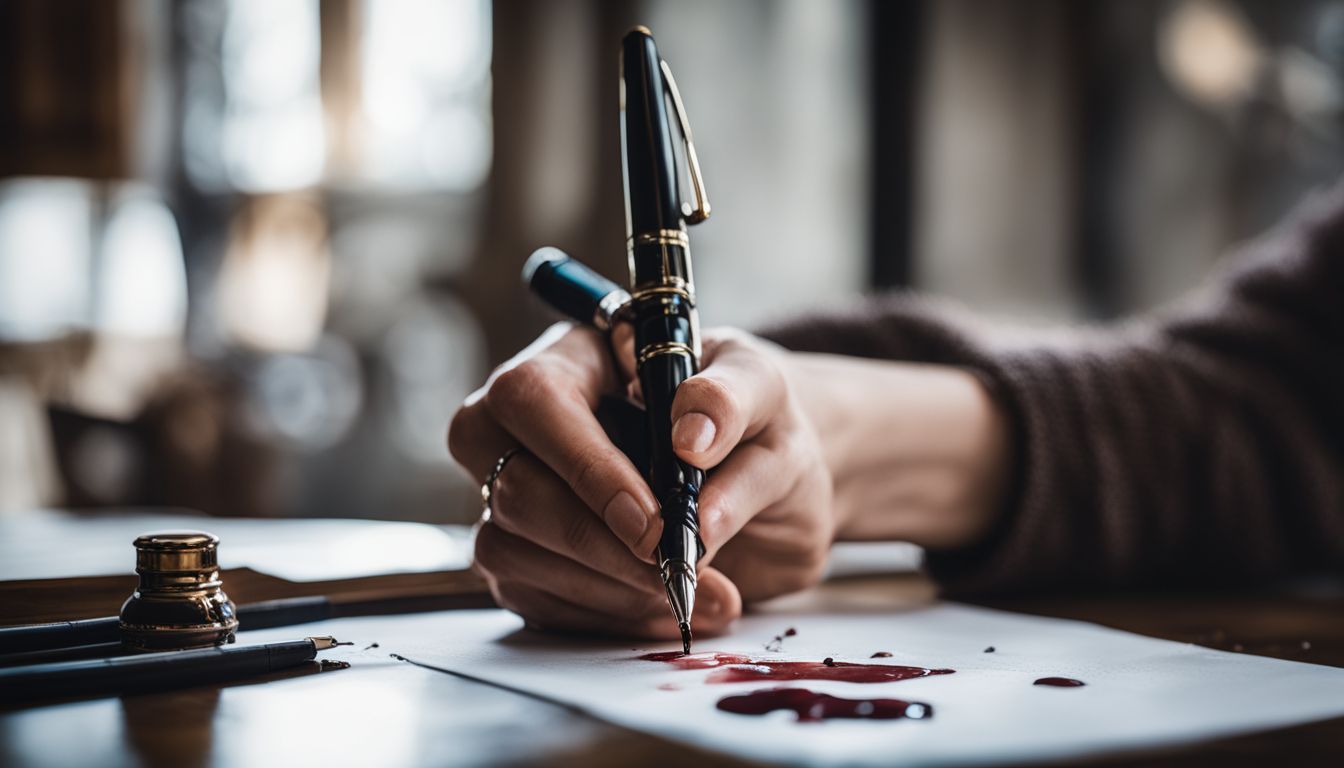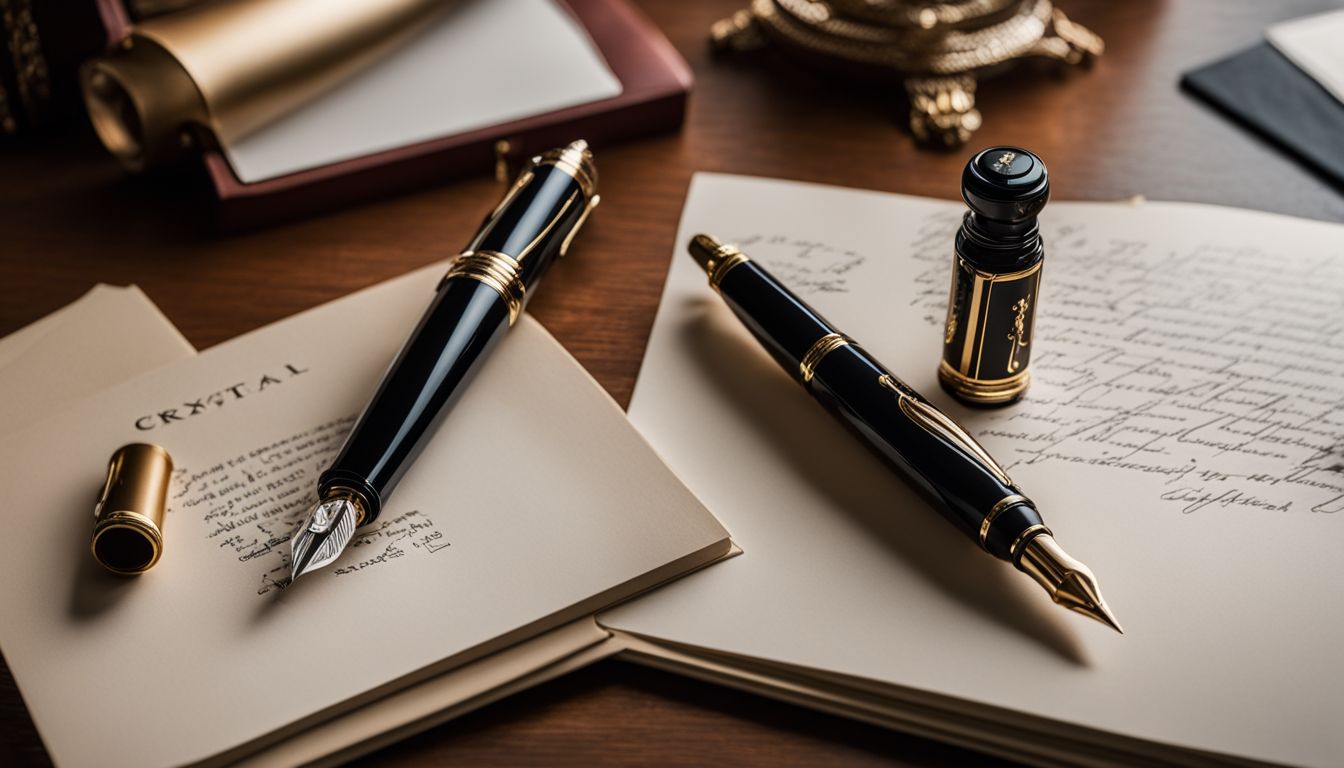Nothing dampens the joy of writing with a fountain pen like unexpected ink smears on your fingers and paper. It’s a fact: fountain pens rely on precise mechanisms to keep their water-based inks contained.
This post is set to arm you with simple, yet effective strategies to maintain your beloved pen and stop those pesky leaks for good. Dive in—your spotless writing experience awaits!
Key Takeaways
- Keep fountain pens away from extreme heat or cold to prevent ink expansion or thickening that can cause leaks.
- Store your pen upright and capped when not in use to fight against gravity and capillary action, which can draw out ink uninvitedly.
- Install ink cartridges cautiously into your fountain pen to avoid spills, and regularly maintain by cleaning and flushing out old ink.
- Inspect new pens for manufacturing defects that might cause leaks, such as cracks or misaligned parts, especially before using them frequently.
- When flying or at high altitudes, fill the ink reservoir completely or empty it to manage air pressure changes; store the pen with nib up and consider using a travel-designed fountain pen.
Causes of Fountain Pen Leaks

Understanding the root of fountain pen leaks is crucial to ensuring a smooth writing experience without the frustration of ink stains. From the unpredictable nature of temperature fluctuations to the intricate science behind capillary action, various factors can turn your cherished writing instrument into an unwelcome mess.
Temperature Changes
Temperature changes can be tough on fountain pens. Warmth from your body heat can make ink inside the pen expand. This might push extra ink into the nib and cause a mess. Keep pens away from hot places to stop this.
For example, don’t leave them in a hot car or near a sunny window.
Cold weather makes ink thicken and move slower. If it gets too thick, your pen might not write when you need it to. Always keep your fountain pen cool but not cold, and definitely out of extreme temperatures either way.
Upright storage is best to avoid leaks caused by temperature swings.
Capillary Action
Capillary action can be tricky. It pulls ink out of the nib and into the cap or even onto your hands. Imagine a plant sucking up water from its roots; that’s how it works in your pen too.
To beat this sneaky force, keep your fountain pen capped when not in use. This simple step cuts down on unwanted ink flow.
Stand pens upright to fight gravity’s pull and capillary action’s push. Pens standing tall means less mess and more writing time! Properly installing an ink cartridge keeps everything flowing smoothly where it should.
Plus, regular check-ups stop leaks before they start—just like going to a doctor but for your pen.
Next up is handling those pesky scratched tips..
Scratched Pen Tip
A scratched pen tip can create big problems for fountain pen users. The tip, or nib, is where the ink flows onto the paper. If it gets scratched, the ink may start to leak out. This often happens when you write at a sharp angle.
To keep your writing smooth and the ink inside your pen, be careful not to tilt your fountain pen too much.
Fixing a scratch on a nib might need a professional’s touch. But you can avoid scratches by using gentle pressure as you write. Keep in mind that different pens need different angles – find what works best for yours.
Now, let’s look into defects from manufacturing that could also cause leaks.
Manufacturing Defects
Even a pen with a flawless tip can fall victim to leaks if it left the factory with hidden flaws. Sometimes, parts inside the fountain pen don’t fit together perfectly. These small mistakes during the making of the pen can lead to big problems like ink leakage.
Tiny cracks or unaligned pieces disrupt the flow of ink.
You may not see these defects right away, but they show up once you start using your pen a lot. If ink starts oozing without any clear reason, check for manufacturing errors. This might mean looking at how well parts connect or if there’s damage you didn’t notice before.
Fixing these issues might require sending your pen back for repairs. Always use pens from trusted brands and examine new pens carefully before using them for the first time.
Tips to Prevent Fountain Pen Leaks

Navigating the nuances of fountain pen care can be pivotal in keeping your cherished writing instrument pristine; with targeted measures from ink selection to maintenance schedules, preserving that elegant Scriveiner script becomes an art in itself—discover how inside.
Proper Ink Installation (Featuring the Scriveiner Fountain Pen)
Installing ink correctly in your fountain pen is a key step to prevent leaks. With the Scriveiner Fountain Pen, you get a smooth experience every time. First, take out the old cartridge or converter with care.
Then, insert the new one gently until it clicks into place. Make sure everything is connected well.
Keep your hands clean during this process – no need for inky fingers! Hold onto the barrel of the pen and avoid touching the nib directly. This prevents damage and keeps ink flowing right where it should be: on paper, not on you! Always cap your pen after filling to keep air pressure from pushing ink out unexpectedly.
Appropriate Storage
Keep your fountain pen safe and ink-free by storing it the right way. Store your pen upright to keep the ink from spilling into the cap. Use a pen holder or stand on your desk for easy access.
Always put the cap on after use to stop leaks onto clothes and desks. Avoid putting your pen in back or hip pockets as bending might cause breaks and leaks.
Take these steps, and you’re ready for regular maintenance of your fountain pen. With care, you’ll enjoy smooth writing without messy leaks or spills. Now, let’s look at how often you should clean and check your fountain pen for any issues.
Regular Maintenance
Regular maintenance is key to keeping your fountain pen in top shape. It helps prevent leaks and ensures a smooth writing experience. Here’s how you can maintain your fountain pen regularly:
- Clean the nib and feed every few weeks to get rid of dried ink. Use room temperature water and let them air dry.
- Check the nib for any damage or misalignment. If you notice issues, carefully realign the tines or replace the nib.
- Flush out old ink from the cartridge or converter with water every time you refill. This prevents clogging and buildup.
- Wipe down the body of the pen with a soft cloth to keep it shiny and free from hand oils or dust.
- Tighten the parts of your pen if anything seems loose. But don’t over – tighten, as this could cause cracks.
Additional Tips for Preventing Leaks During Flights or High Altitudes
Flying with fountain pens can be tricky. High altitudes may cause ink to leak from your pen.
- Use a full or empty cartridge: Before you fly, either fill the ink reservoir completely or use it up. This leaves no room for air that might expand and force ink through the nib.
- Keep the pen upright: Store your fountain pen with the nib pointing up during the flight. This position helps prevent ink from leaking out of the nib.
- Store in a Ziploc bag: Place your fountain pen in a plastic bag before takeoff. If any leaks happen, they stay inside the bag and off your clothes.
- Consider a dedicated travel pen: Some pens are designed for travel with tighter seals. Look into getting one if you fly often.
- Skip using the pen on board: Wait until you land to write with your fountain pen. The pressure will normalize and reduce leakage risks.
- Don’t forget temperature changes: Inside an airplane, temperatures can shift quickly. Be mindful as this can also cause ink to flow more freely.
- Acclimate after landing: Once you land, give your pen time to adjust to ground level conditions before using it again.
Conclusion
Take care of your fountain pen, and it will serve you well. Remember to keep it cool, upright, and properly maintained. Don’t forget the flight tips if you’re heading to high altitudes.
Share your tips below—we all learn from each other! Love your pen, and say goodbye to leaks for good.
Discover the elegance and reliability of a Scriveiner Fountain Pen for an unparalleled writing experience.
FAQs
1. How do I stop my fountain pen from leaking?
To prevent leaks, make sure you conduct regular pen maintenance. Check seals, clean out old ink to avoid liquefaction, and store your pen properly—upright is best to keep the ink in place.
2. Does writing angle affect fountain pen leaks?
Absolutely! Using the correct writing angle reduces pressure on the nib and prevents unwanted ink flow that causes leaks. So hold your pen just right—not too flat or too upright.
3. Can I use markers or ballpoints instead of a cartridge pen to avoid leaks?
Sure, you can opt for markers, rollerballs, or ballpoint pens as they are less prone to leakage compared to cartridge pens due to their design and ink type.
4. What’s the best way to store pens when not using them?
Store your pens with care by keeping them in a cool place and standing up vertically when possible; this helps stop ink from going where it shouldn’t and keeps your pens ready for smooth writing every time.




Leave a Reply
You must be logged in to post a comment.